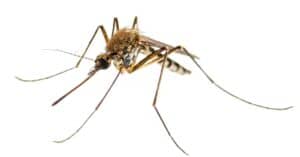As temperatures rise, mosquitoes become more active. These pesky insects can make spending time outdoors a real challenge. From the common house mosquito to the aggressive Asian tiger mosquito, understanding the types of mosquitoes found in Pennsylvania can help you better protect yourself from these blood-sucking pests.
So, let’s dive into the world of mosquitoes and discover what types are set to invade Pennsylvania this summer.
Asian Tiger Mosquito (Aedes albopictus)
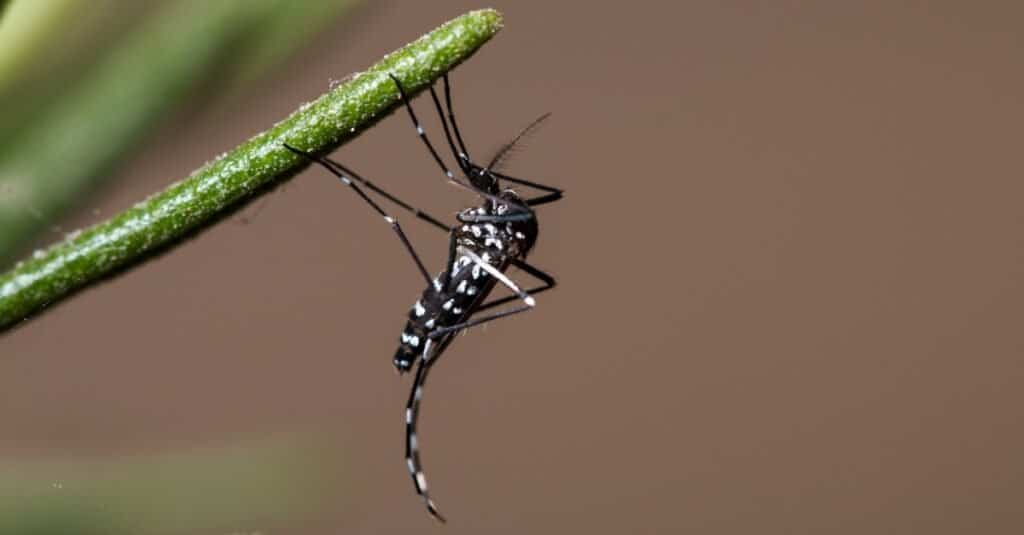
With its rapid and incessant multiplying, the Asian
tiger
mosquito causes significant concerns in the United States.
©Oliver Spiteri/Shutterstock.com
A non-native species, the Asian tiger mosquito has been multiplying rapidly in Pennsylvania and the United States, causing significant concerns. It has become the primary mosquito pest in several counties where mosquito problems were previously uncommon.
You can identify this particular mosquito species by its distinct black-and-white striped pattern and its roughly quarter-inch length.
The Asian tiger mosquito poses a serious health risk to both humans and livestock as it is extremely aggressive. The bite of this mosquito can spread various dangerous illnesses. These include dengue fever, yellow fever, and viral infections that may result in brain inflammation.
This mosquito feeds during the day. It hangs around shady areas, where it rests on the ground near shrubs. They usually inhabit areas near water bodies as it is a requirement for their eggs to hatch. The male mosquito primarily feeds on plant juices and does not bite. The female, though, feeds on blood for egg development.
In Pennsylvania, the population of Asian tiger mosquitoes increases during mid-July and peaks in mid-August. It decreases in September when night temperatures drop.
Common House Mosquito (Culex pipiens)
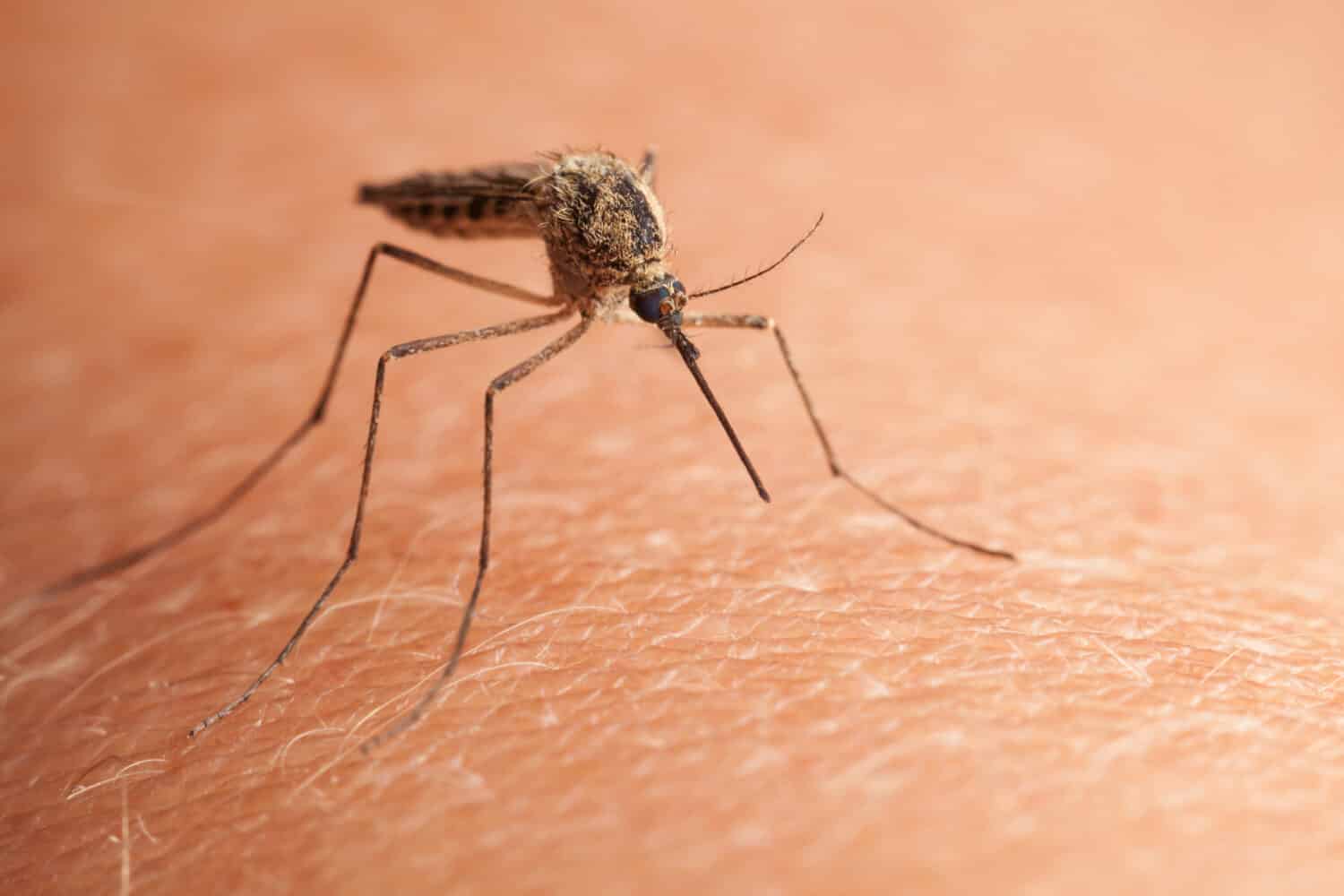
The common house mosquito is active primarily at night.
©Anest/Shutterstock.com
Displaying a varying range of colors such as grey, white, silver, green, or iridescent blue scales, the common house mosquito is common in Pennsylvania. They possess two wings, long legs, a pair of antennae, and a slim body, which may slightly differ in size depending on when they last fed.
These mosquitoes can be dangerous as they can spread diseases. These include St. Louis encephalitis and West Nile fever, along with viral illnesses in horses and birds.
They are mostly active during the night and tend to enter homes to feed between sunset and sunrise. A single mosquito is capable of causing a lot of trouble by biting multiple times. This is because the female mosquito needs to feed on blood to lay her eggs.
Common house mosquitoes are highly adaptable and can survive in both clean and polluted water bodies, including poorly maintained sewers and cesspools. While they have a tendency to bite humans, common house mosquitoes prefer birds such as doves and pigeons. In general, though, they feed on the blood of various vertebrates.
These mosquitoes can be commonly spotted in Pennsylvania from April to September, and they can be quite a nuisance.
Inland Floodwater Mosquito (Aedes vexans)
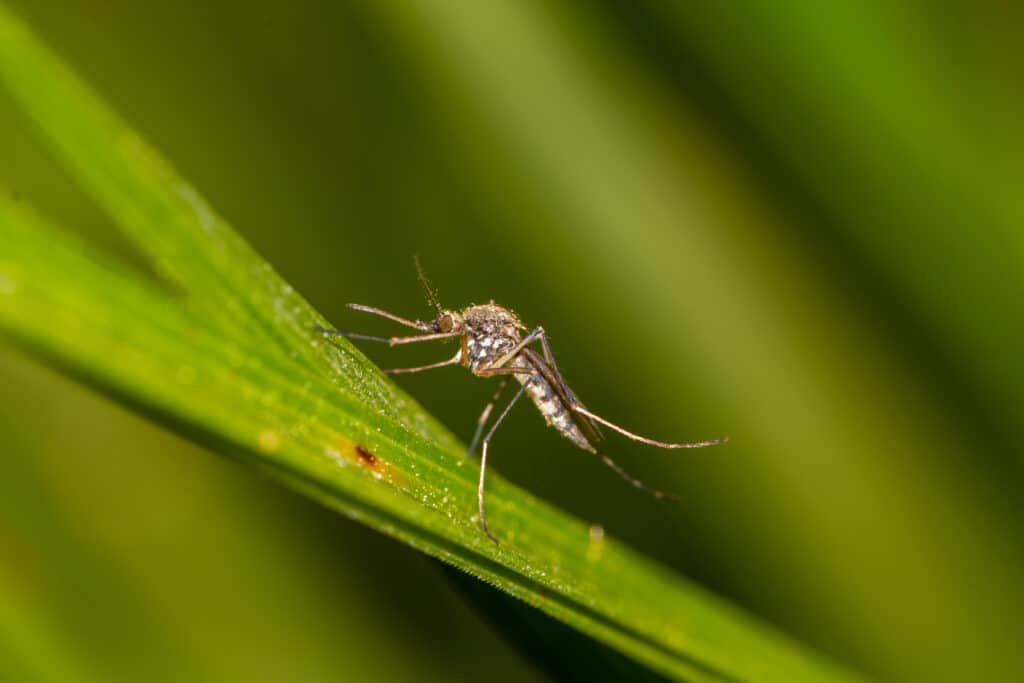
While female inland floodwater mosquitoes feed on blood, males feed on nectar, honeydew, and sap.
©Roziline/Shutterstock.com
Pennsylvania is home to more than 60 different species of mosquitoes, including a notorious type known as the inland floodwater mosquito. This mosquito’s distinguishing features include a short, brown-scaled scutum, a bandless proboscis, and B-shaped markings on each abdominal tergite.
Measuring 1/4 inch long, only the female of this species feeds on blood, with humans and cattle being its preferred hosts. In contrast, the male feeds on nectar, honeydew, and sap, which the females occasionally feed on as well, albeit infrequently. These mosquitoes typically inhabit grassy pools, woodland pools with partial shading, roadside ditches, and cultivated fields.
The inland floodwater mosquito is particularly aggressive, and its bite can be quite painful. Its ability to travel more than a couple of miles from its breeding site means that it can cause problems over a wide area.
Additionally, this species is a vector for several diseases. Those include myxomatosis (a deadly virus affecting rabbits), Dirofilaria immitis (dog heartworm), and tahyna virus, a type of Bunyaviridae virus. While the virus can cause a fever that disappears after a couple of days, it can subsequently lead to encephalitis or meningitis.
These blood-sucking insects are active in Pennsylvania from April to October.
Eastern Tree Hole Mosquito (Aedes triseriatus)
A type of true fly, the eastern tree hole mosquito prefers to breed in the stagnant water of natural holding containers like tree holes. Silvery scales cover the sides of the thorax, making it easily identifiable. Dark, unbanded abdominal segments are also a distinguishing feature of the eastern tree hole mosquito.
Adult female mosquitoes tend to lay eggs in shaded forested areas with dense underbrush, avoiding open areas. These terrestrial insects can be found in both forests and suburban areas near wooded regions. Adult mosquitoes mainly feed on nectar, with males exclusively consuming it. Females also take blood meals, feeding on birds and mammals, including humans.
With their painful and irritating bites, eastern tree hole mosquitoes are not just a nuisance, they also transmit the La Crosse encephalitis virus in the United States. La Crosse encephalitis virus frequently goes unnoticed, but it has the potential to cause symptoms like fatigue, headache, fever, vomiting, and nausea. Severe cases, especially in children, may lead to seizures, coma, and paralysis.
Eastern tree hole mosquitoes are active in Pennsylvania from May to October, primarily in the early morning and late afternoon.
Common Malaria Mosquito (Anopheles quadrimaculatus)
Malaria is a fatal disease caused by a parasite that infects certain species of mosquitoes which feed on humans. The common malaria mosquito, which is covered in black to dark brown hairs and has dark scales on its wings, is one such species. This mosquito species is approximately 0.17 inches long and has four darker spots on its wings made up of patches of scales.
Common malaria mosquitoes are typically found in man-made and natural ponds, drainage ditches, swamps, tire tracks, and puddles. Similar to all other types of mosquitoes, both male and female mosquitoes obtain energy by consuming nectar and plant sugars. However, female mosquitoes also need to feed on blood to obtain nutrients that are essential for the growth and development of their eggs.
Malaria is primarily spread through the bite of an infective female mosquito of the Anopheles species. These mosquitoes can only transmit malaria if they have previously fed on an infected person.
Although the United States was once malaria-endemic, the disease was declared eliminated in the country in 1951. Despite that, the country still reports approximately 1,500 cases of the disease every year.
Common malaria mosquitoes are most active during dusk or dawn and at night. These insects are usually observed between April and October, with their presence being influenced by weather conditions. Rainy seasons may help these mosquitoes to thrive and multiply at an exceptional rate.
When Are Mosquitoes At Their Peak In Pennsylvania?
Mosquitoes in Pennsylvania are typically at their peak from late April to October. The arrival and departure of mosquitoes in Pennsylvania are heavily influenced by weather conditions. Rainy seasons can help these pesky insects grow and multiply, while an early arrival of cold days can cause them to disappear.
Delayed cold weather, on the other hand, can make them stay around for a longer period. Therefore, variations in weather patterns can affect the population of mosquitoes and the duration of mosquito season in Pennsylvania.
Other Insects Set to Emerge in Pennsylvania
Here are some other insects that will emerge as the weather warms up in Pennsylvania.
Brown Marmorated Stink Bug (Halyomorpha halys)
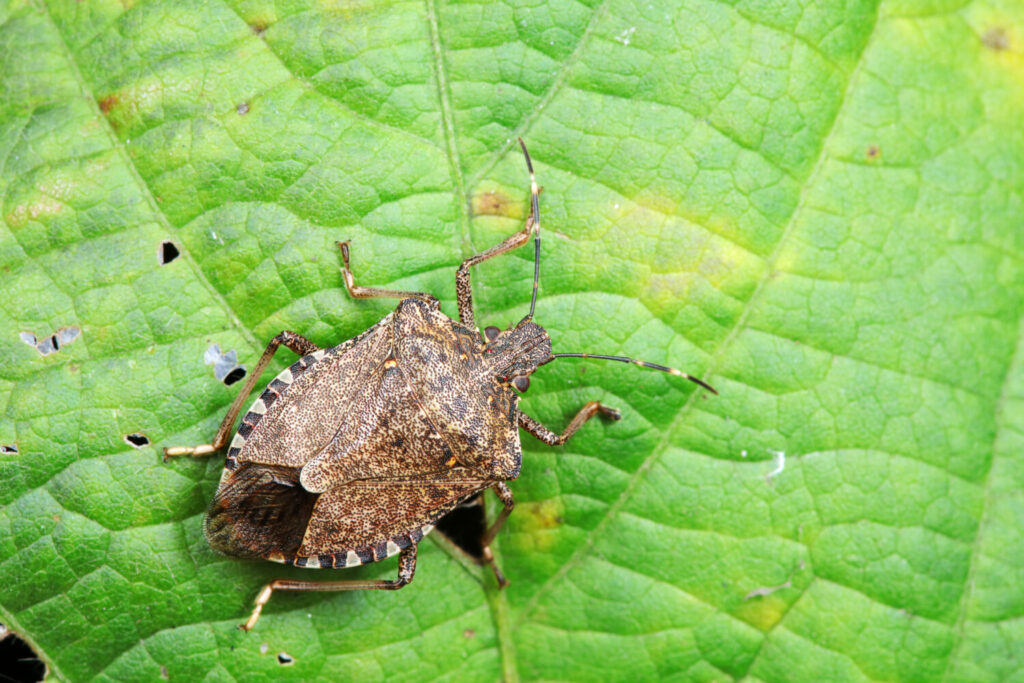
While the brown marmorated stink bug is originally from Asia, it arrived in the United States in the 1990s, and is now an invasive species.
©junrong/Shutterstock.com
In various regions of the United States, the brown marmorated stink bug, an invasive insect, lives. Originally from Asia, this species arrived in the US by chance during the mid-1990s, presumably by hiding in a shipping container.
With a shield-shaped body covered in brown spots, the adult brown marmorated stink bug is comparable in size to a dime in the US. It has alternating wide, light, and dark bands on the edges of its abdomen and the final two segments of its antennae.
The stink bug is not harmful to humans or animals, and it does not cause any structural damage to buildings. However, their large numbers can be a considerable nuisance. These bugs release a foul odor from their abdominal scent glands when disturbed or crushed, giving them their name.
The peak season for stink bug activity is primarily from March to September, while adult brown marmorated stink bugs search for winter habitats in early fall.
Spotted Lanternfly (Lycorma delicatula)

Another invasive species, the
spotted lanternfly
, has spread throughout Pennsylvania.
©vm2002/Shutterstock.com
Since its discovery in Berks County in 2014, the spotted lanternfly, an invasive species, has rapidly spread throughout Pennsylvania.
Measuring roughly an inch in length and half an inch in width, these insects have gray forewings with black spots. When in flight, they reveal their red and black hind wings. The black legs, black head, and yellow abdomen with black bands make them easily identifiable.
Although spotted lanternflies are not harmful to humans or pets since they neither bite nor sting nor contain venom, they can cause significant damage to agriculture. The spread of infested material or items containing egg masses by humans can transport these insects over long distances.
Adult spotted lanternflies can be observed in Pennsylvania during the summer and fall months. However, the arrival of cooler temperatures offers temporary relief from the invasion as the first frost kills adult spotted lanternflies.
Giant Eastern Cranefly (Pedicia albivitta)

You’ll know a cranefly when you see one, with a long body of an inch and a half.
©Conrad Barrington/Shutterstock.com
The giant eastern cranefly is a fragile insect, and despite its large size, it is gentle in nature. With a body length of one and a half inches, a wingspan of three inches, and a leg spread of four inches, this cranefly can easily damage its legs. It is easily identifiable by the white band on its abdomen, which distinguishes it from a colossal mosquito, although many people often mistake it for one.
If you find a giant eastern cranefly in your house bouncing around on walls and ceilings, there is no need to worry, as they are harmless. Contrary to popular belief, these crane flies do not prey on mosquitoes, nor are they a larger version of the insect.
It is interesting to note that crane flies primarily consume nectar or do not eat at all. Their mouthparts are thicker and blunter than other insects and often feature unusual structures. In some cases, they may not even have mouthparts at all. It is easy to distinguish between male and female crane flies, even in flight. Males have a clasper-type tip on their abdomen, while females have a pointed ovipositor.
In the state of Pennsylvania, the giant eastern cranefly is commonly seen during late summer and can be observed until late fall.
Dog-Day Cicada (Neotibicen canicularis)
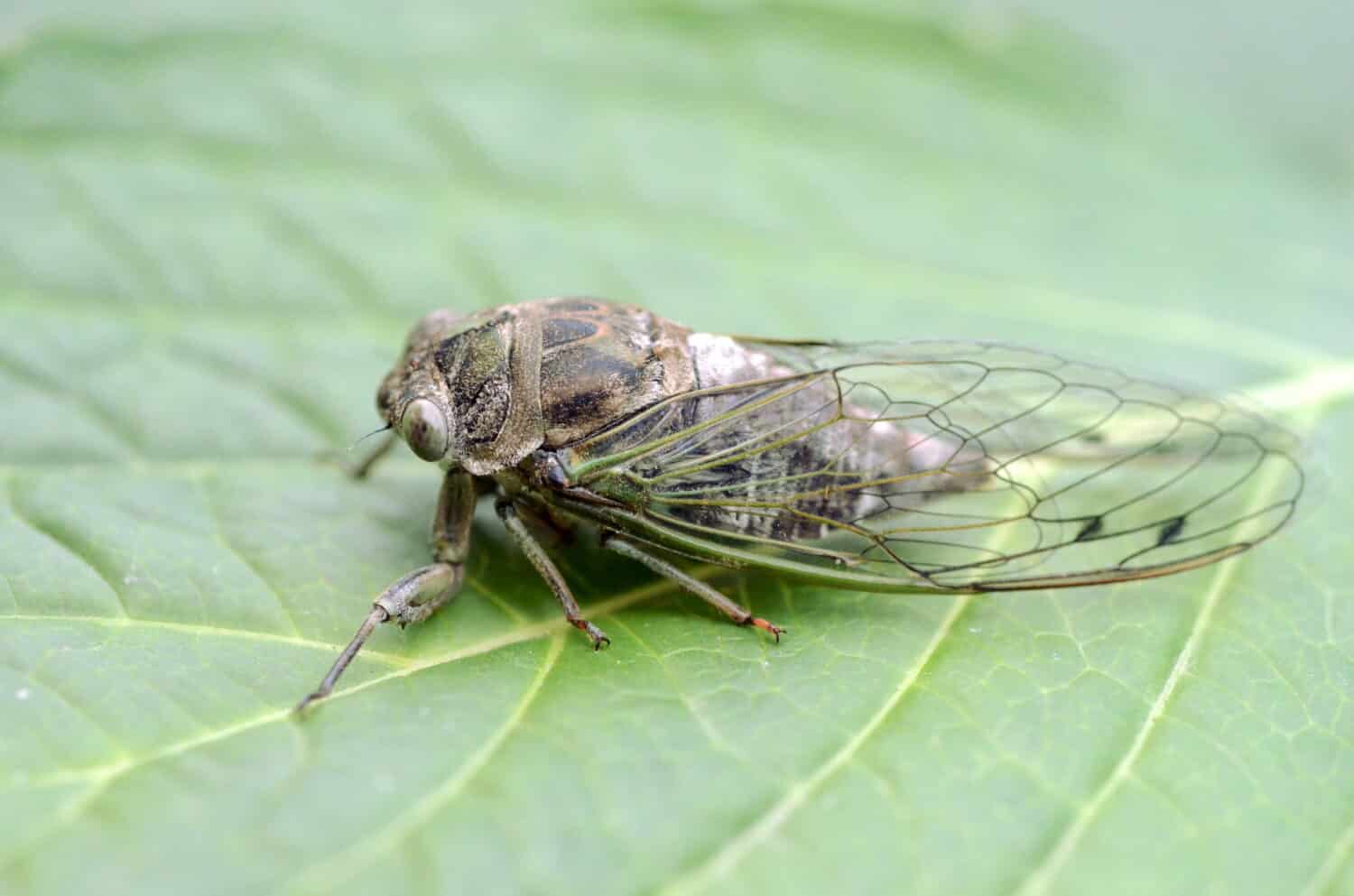
As much as they may frighten some, dog-day cicadas are harmless.
©Akvals/Shutterstock.com
During the hottest days of summer in Pennsylvania, it is common to spot the harmless dog-day cicada. With elongated bodies that are double the length of their width, these insects exhibit distinctive features that predominantly consist of dark shades with green and black markings on their thorax. They typically inhabit mixed and deciduous woods.
Even though these cicadas do not cause any harm to humans, around 5-6% of adults and 10% of children experience insect phobias and may find them unappealing.
Pet owners need not worry about their furry friends, as cicadas are not dangerous to pets. Ingesting a large number of cicadas may cause temporary stomach upset or vomiting. A small number, though, should not be a concern.
In Pennsylvania, dog-day cicada usually emerges in July and August, coinciding with the “dog days of summer.”
Multicolored Asian Lady Beetle (Harmonia axyridis)
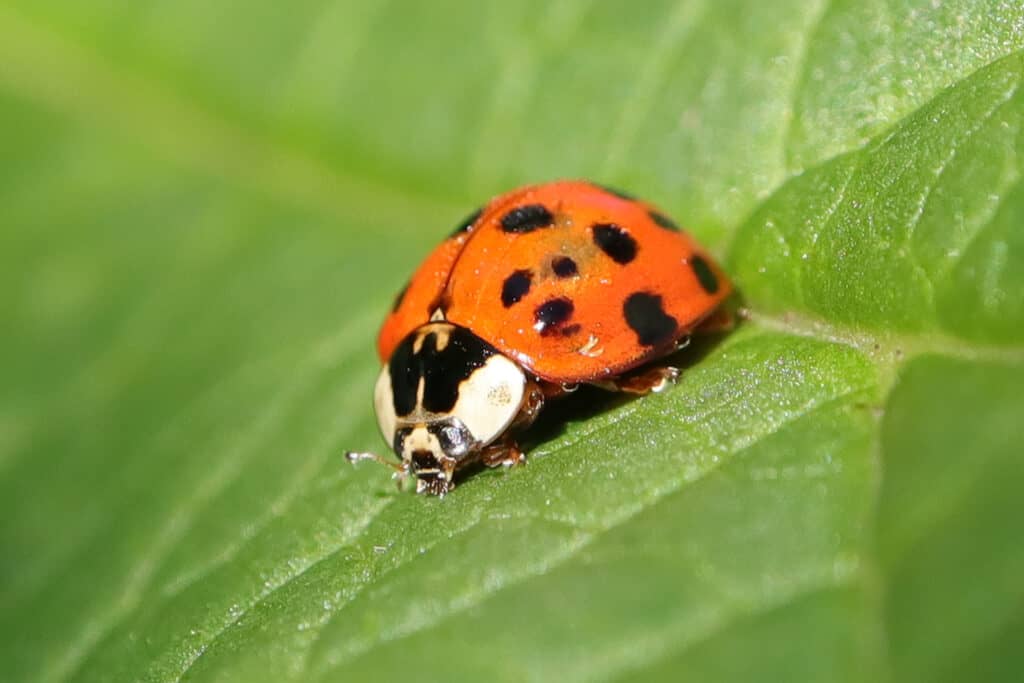
While many are red, multicolored Asian lady beetles can be orange or yellow.
©iStock.com/DE1967
The multicolored Asian lady beetle was initially introduced to Pennsylvania in 1978 and 1981 as a means of controlling crop pests, such as aphids. They closely resemble other lady beetles but are typically larger, measuring around 1/3-inch long. Multicolored Asian lady beetles exhibit a range of hues. These include orange, yellow, and red. Black is a less common coloration.
Despite being intentionally introduced by the US Department of Agriculture, the multicolored Asian lady beetle is now considered an invasive species and a nuisance to households. Although they are capable of biting, they are not venomous.
The primary concern associated with these beetles is the discomfort they cause to homeowners. They tend to gather in large numbers, sometimes tens of thousands, within attics, ceilings, and wall voids. Due to the warmth of these areas, they may move around within the voids and eventually exit into living spaces within the home.
During the fall, it is common to see large clusters of lady beetles around homes and other buildings as they search for overwintering sites.
The photo featured at the top of this post is © Anest/Shutterstock.com
Thank you for reading! Have some feedback for us? Contact the AZ Animals editorial team.



